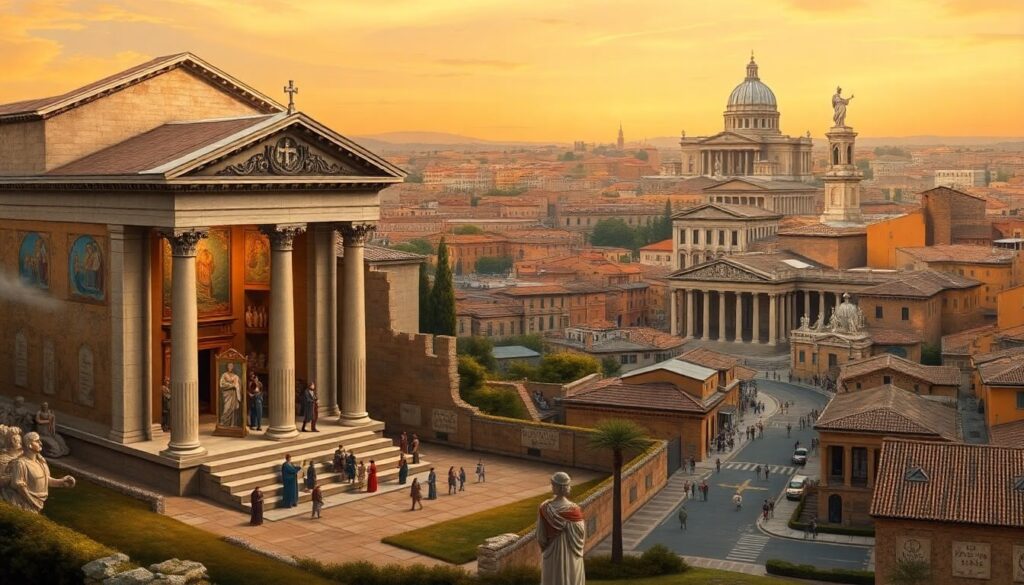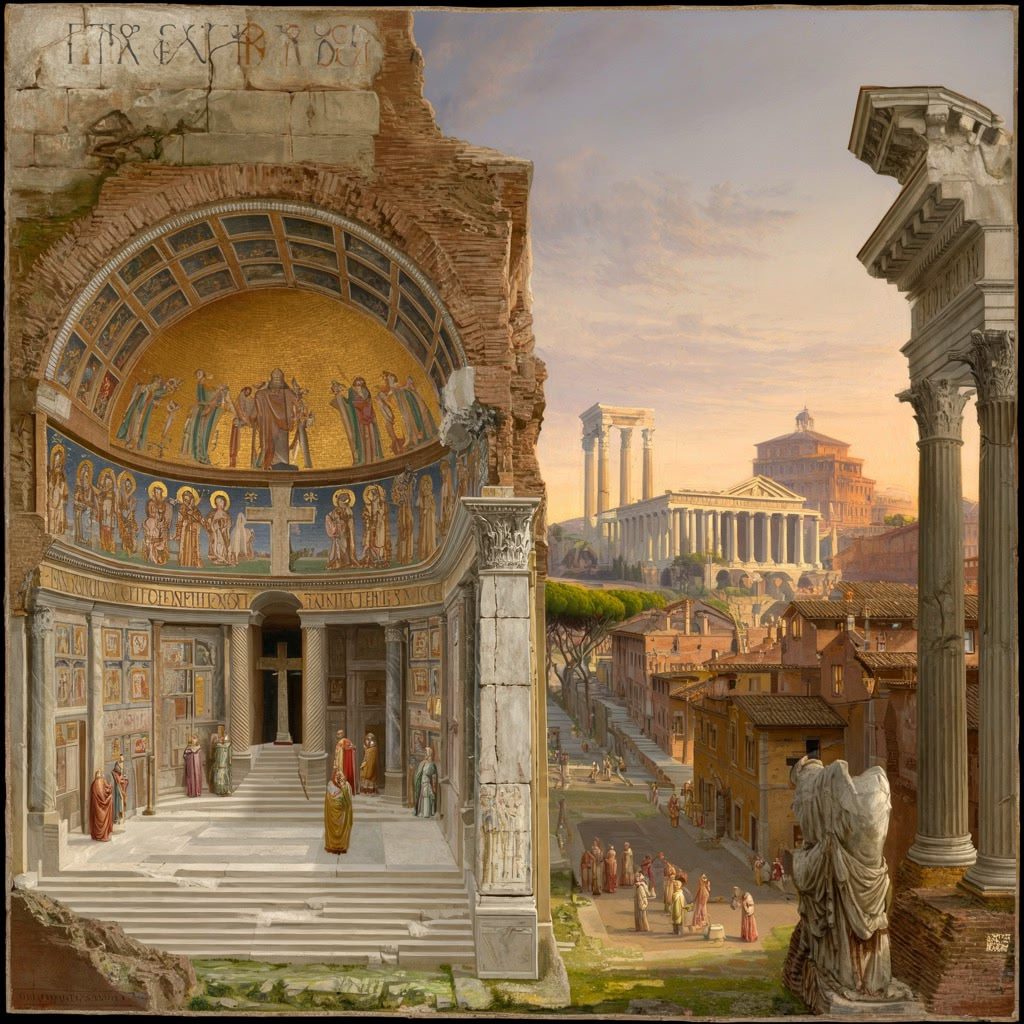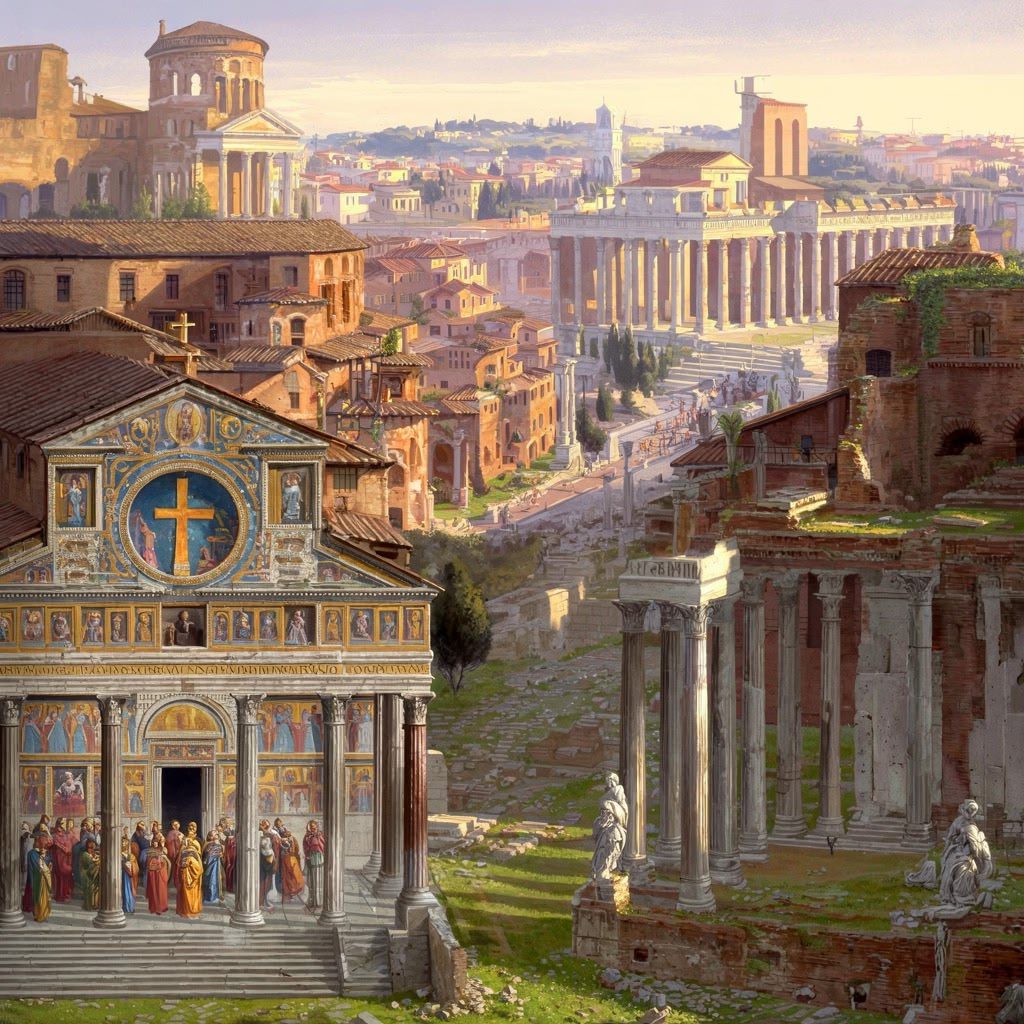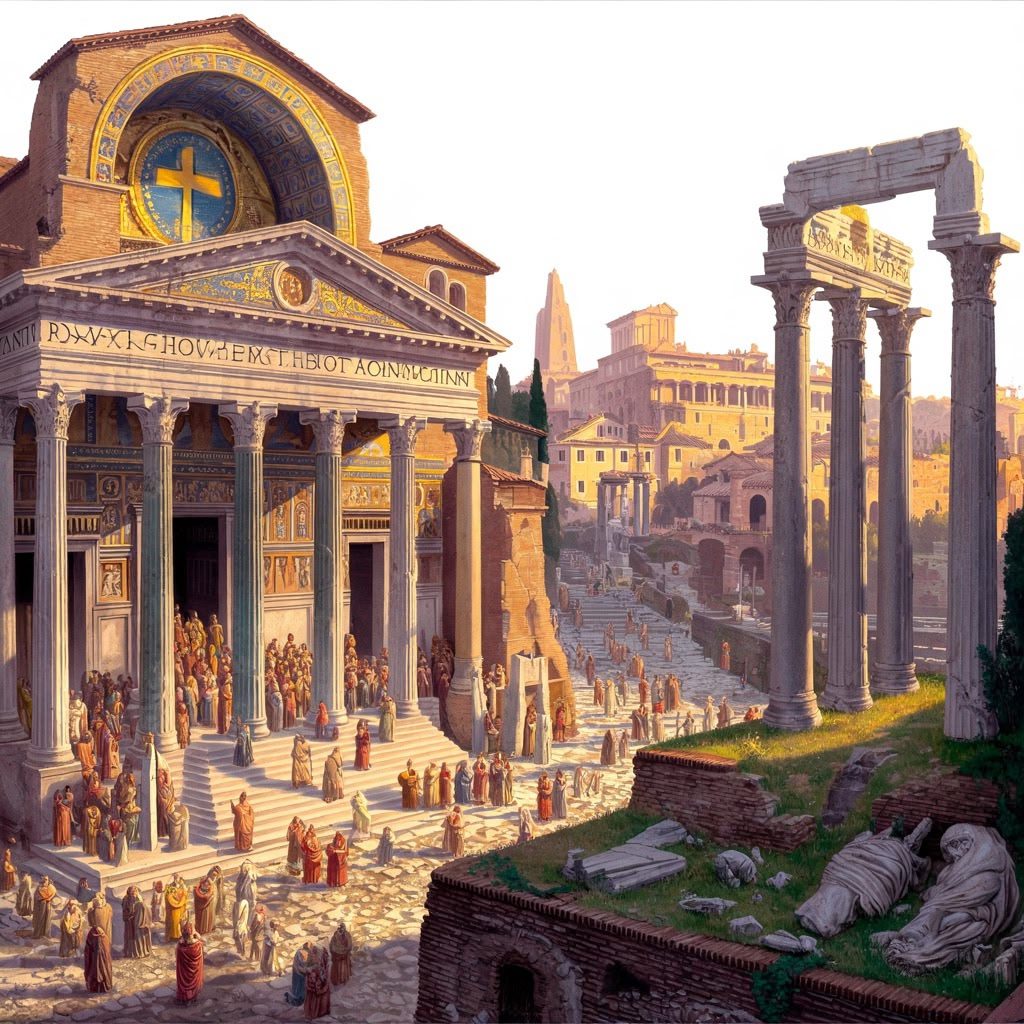The transformation of religious spaces in Rome from Paganism to Christianity is a critical historical journey that shaped the spiritual and cultural landscape of the ancient city. This evolution holds profound significance, representing not just a change in religious beliefs but also a redefinition of sacred spaces and societal norms.
The impact of this transition can be better understood within the broader context of Ancient Roman society, where entertainment and public spectacles played a crucial role. These activities not only served as leisure but also significantly affected social relationships and political authority.
The architectural transformation during this period was not just limited to religious structures but also extended to public buildings and spaces which were integral to Roman legal systems and societal functioning. The Twelve Tables, for instance, marked a significant milestone in the development of Roman law and legal history.
Moreover, this transition is part of a larger narrative about the rise and fall of the Roman Empire, a civilization that has left an indelible mark on the world. The legacy of Ancient Rome continues to shape various aspects of modern society, as seen in its influence on governance, culture, and societal norms.
This article delves into the multifaceted aspects of how the transition from Paganism to Christianity influenced the architectural, social, and cultural fabric of Rome’s religious spaces.
Historical Background
The transformation of religious spaces in Rome occurred during a dramatic shift in the Roman Empire’s spiritual landscape. Christianity, once a persecuted faith, gradually rose to prominence and eventually became the state religion under Emperor Constantine in the early 4th century CE. This political endorsement accelerated the decline of paganism, which had dominated Rome’s religious life for centuries.
The fate of pagan temples varied greatly during this transition:
- Some temples were destroyed outright, symbolizing a clear break from former polytheistic traditions.
- Others were converted into Christian churches, repurposed to serve new liturgical functions without complete demolition.
This approach was often pragmatic rather than purely ideological. The reuse of monumental pagan structures served practical needs—offering ready-made sacred spaces for Christian worship—and reinforced the new religion’s authority by physically replacing old deities with the Christian God.
Converting temples also allowed Christians to appropriate well-known landmarks, embedding their faith into the urban fabric of Rome. This duality—destruction paired with adaptation—reflects how Christianity navigated its ascent within an empire rich in religious history.
Understanding this transformation requires a glimpse into the broader context of Roman governance, which existed from 509 to 27 BCE. This period marked a significant transition in governance from monarchy to a complex political structure, laying the foundation for modern democracies.
Moreover, agriculture, as a crucial driver of Rome’s economic and social development, played an essential role during both the Republic and Empire phases.
Additionally, figures like Scipio Africanus, known for his crucial role in the Second Punic War, significantly influenced Roman history and its subsequent rise to power.
Lastly, it’s important to recognize that before this transition towards Christianity, ancient Rome was characterized by a rich tapestry of religious practices that intertwined with every aspect of life. From politics to culture and social structures, religion served as a cornerstone of Roman identity, influencing various facets of their expansive empire.

Architectural Shift
The emergence of Christian basilicas as the primary centers of worship marked a significant shift in Rome’s religious architecture. These basilicas replaced the traditional pagan temples, which had once dominated the landscape. Unlike pagan temples designed primarily as houses for deities focusing on external rituals, Christian basilicas emphasized congregational gatherings and communal worship inside the structure.
Key architectural differences between these two types of structures include:
- Layout: Pagan temples typically featured a small inner sanctum (cella) for statues of gods, surrounded by open colonnades. In contrast, Christian basilicas adopted a longitudinal plan with a spacious nave, side aisles, and an apse, accommodating large groups of worshippers.
- Function: While pagan temples served as places for individual offerings and sacrifices carried out by priests, Christian basilicas functioned as public spaces for liturgical ceremonies, preaching, and sacraments.
- Design elements: The basilica design incorporated clear sightlines towards the altar and ample room for processions. Decorative motifs shifted from mythological scenes to Christian iconography such as crosses, biblical mosaics, and frescoes.
The architectural transformation involved adapting existing pagan structures to fit Christian liturgical needs often required repurposing or modifying architectural features. For example:
- The Temple of Venus and Roma was converted into a church by adding an apse.
- Columns and porticos were retained but reinterpreted symbolically within a Christian context.
- Pagan altars were replaced with Christian altars oriented towards the east, reflecting the direction of Christ’s anticipated return.
This architectural transformation reflected not just aesthetic preferences but also a fundamental shift in religious practice—moving from exclusive priestly rites to communal worship centered on scripture and sacraments within a sacred yet accessible space. This transition is also mirrored in other aspects of Roman life such as the Roman Army, which played a crucial role in the growth and upkeep of the Roman Empire, or Roman Law, which has significantly influenced modern legal systems.
In addition to these shifts in architecture and religion, there are also unique opportunities to explore these changes in a more immersive way. For instance, role-playing games like Second Life offer platforms where individuals can engage with historical themes such as those found in Roman architecture or the significance of Roman roads in maintaining and expanding the empire.

Monotheistic Nature of Christianity
Christianity’s monotheistic nature fundamentally shaped the transformation of religious spaces in Rome. Unlike the polytheistic Roman religion, which embraced a pantheon of gods and localized deities, Christianity demanded exclusive worship of a single, all-powerful God. This exclusivity led to a clear and deliberate break from the traditional pagan religious practices.
Key aspects of this transformation include:
- Rejection of pagan gods and rituals: Pagan temples, once vibrant with multiple idols and rituals dedicated to various deities, became incompatible with Christian worship. The presence of multiple gods conflicted with the Christian doctrine that emphasized one God’s sovereignty.
- Erasure of pagan symbolism: As Christianity expanded, efforts intensified to remove or obscure images and symbols associated with paganism from sacred spaces. This was not only theological but also symbolic—a way to physically assert the dominance of Christianity over former pagan beliefs.
- Exclusive worship shaping space use: Christian liturgy focused on communal prayers and sacraments centered on Christ, requiring different spatial arrangements within converted temples or newly built basilicas. Spaces previously designed for sacrifices to many gods were repurposed for singular devotion.
The shift from polytheism to monotheism redefined how Romans experienced their sacred environments. This theological exclusivity directly influenced architectural forms, iconography, and ritual practice—marking a decisive step from Paganism to Christianity: The Transformation of Religious Spaces in Rome.
However, the transition wasn’t solely about religious beliefs. It also intersected with legal and philosophical transformations in Roman society. For instance, the Corpus Juris Civilis, or Body of Civil Law, commissioned by Emperor Justinian I in the 6th century AD, served as a comprehensive codification that preserved ancient Roman legal principles while adapting them to contemporary society’s needs. This marked a crucial turning point in the development of legal systems in Europe.
Moreover, the rise of Stoicism, a philosophical school founded by Zeno of Citium around 300 BCE in ancient Greece, significantly influenced Roman thought. Its principles emphasized living in harmony with nature, using reason, and practicing virtue as paths to achieving eudaimonia or human flourishing.
Additionally, while Christianity supplanted many aspects of the traditional Roman religion, it didn’t entirely erase the influence of Roman mythology on modern culture. The Romans had adapted these myths from Greek origins to reflect their societal norms and political aspirations.

Social and Cultural Impact
The transition from paganism to Christianity in Rome extended beyond grand temples to encompass more intimate spaces like homes and cemeteries.
Transformation of Homes and Cemeteries
- Homes, once adorned with pagan symbols and used for rituals honoring various gods, underwent a profound shift towards Christian significance.
- Symbols of the old beliefs were replaced with Christian iconography, creating an environment conducive to the new faith.
- Cemeteries, which held deep religious importance for Romans, saw a transformation in symbolism and practices.
- The shift from pagan burial rites to Christian ceremonies marked a significant societal change.
Broader Implications of this Transformation
The elimination of pagan symbols and rituals in these spaces reflected the broader cultural impact of Christianity’s ascendancy.
This evolution of sacred spaces within homes and cemeteries not only mirrored the religious conversion but also highlighted the deep-rooted changes taking place in Roman society as a whole. The gradual displacement of pagan elements by Christian symbols signaled a profound cultural realignment towards monotheism and exclusivity in worship.
These shifts were not just limited to religious practices but also extended into various aspects of daily life in ancient Rome, which was vastly different for the various social classes. For instance, the daily life in ancient Rome varied significantly between patricians and plebeians, influencing their traditions and ways of living.
Moreover, the transformation also coincided with significant advancements in Roman engineering, which played a crucial role in connecting far-flung regions and ensuring effective governance and cultural exchange. This engineering prowess served as a foundation for contemporary infrastructure systems.
Additionally, the era was marked by complex social structures that even extended to entertainment forms such as gladiatorial games. The gladiators, admired for their battle skills yet victims of a harsh social system, symbolize another facet of Roman society during this transformative period.
Lastly, understanding the political landscape during this transition is essential. The birth of the Roman Republic, marked by the overthrow of monarchy around 509 BCE, represents a pivotal moment that influenced modern political structures.

Conclusion
The transformation of religious spaces in Rome from paganism to Christianity marked a profound spiritual shift that redefined the city’s sacred landscape. The decline of paganism was not merely about the physical alteration of temples and shrines but represented a deeper change in belief systems and religious identity. This shift was accompanied by a significant cultural shift, reshaping social practices, art, and communal life around Christian values.
Key reflections on this transformation include:
- The repurposing of pagan temples into Christian churches symbolized the rise of Christianity as the dominant faith, embedding it physically and symbolically into Roman society.
- Architectural adaptations mirrored theological changes, emphasizing monotheistic worship and new liturgical needs.
- The removal of pagan symbols and integration of Christian iconography reflected an intentional effort to assert the exclusivity of Christianity.
- Changes extended beyond grand public spaces to private homes and burial sites, indicating how thoroughly Christian beliefs permeated everyday life.
This process illustrates how religion can reshape urban environments profoundly, reflecting shifts in power, identity, and worldview.
To understand these shifts better, it’s essential to explore various aspects of ancient Roman society. For instance, the legal status of Roman women reveals a complex interplay of rights and restrictions that significantly influenced gender dynamics in ancient Rome. Similarly, examining the lives of plebeians, who were vital to the fabric of Roman society, can provide insights into the social dynamics during this transformative period.
Moreover, understanding art and culture in ancient Rome is crucial as these elements were heavily influenced by earlier traditions and played a significant role in shaping the societal landscape. Lastly, recognizing the role of patricians as masters of Roman luxury and power adds another layer to our understanding of this historical transformation.
From Paganism to Christianity: The Transformation of Religious Spaces in Rome reveals more than architectural evolution—it captures a pivotal moment when Rome reinvented itself spiritually and culturally for centuries to come.

